How to tie a blackberry correctly?

Blackberries are a garden crop that requires a lot of attention. It must not only be cut in spring and autumn, fed with vitamins and minerals, but also properly tied up.
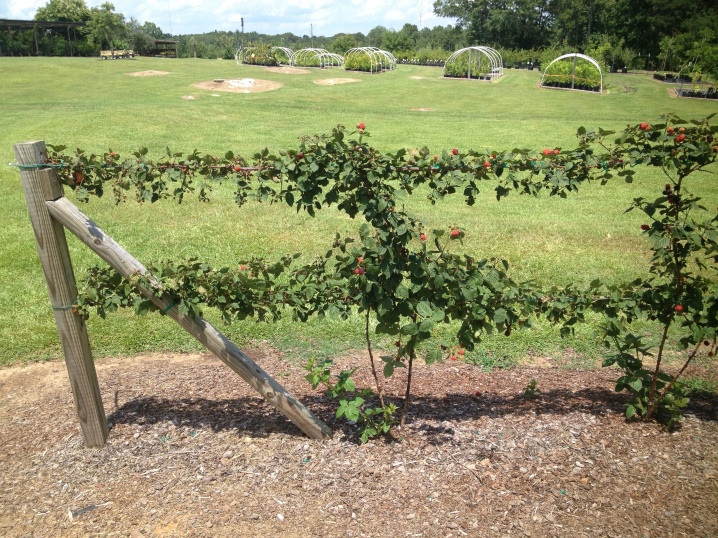
The need for support
Blackberries grow rather quickly and reach a height of 1.5-2 meters. If it is not tied up already at the level of young shoots, it will turn into an overgrown bush, which will be very difficult to care for, especially during winter laying. Trellises are a universal support option - a lattice structure for supporting bushes.
Blackberry branches are flexible but brittle. During strong winds or heavy rain, as well as under the weight of their own crops, they break. And support in this case is necessary.
Most varieties of blackberries have thorns on their stems, which can make harvesting difficult. If the whole mass of branches lies on the ground, then you will not get close to the berries. Imagine the whole structure: young shoots are just beginning to grow, but old branches press down on them from above. They prevent the sun's rays from reaching new stems, for which reason they die. Blackberry is a sun-loving plant.

There are several ways to tie a blackberry.
- With the help of trellises. Tapestries prevent young shoots from dying. The branches do not bend under their own weight or due to unfavorable weather conditions. Every part of the plant gets enough sun. At the same time, the trellises do not harm the branches, as they are made of natural materials or slippery metal.
- Bundle garter. This method is applicable only for the duration of soil cultivation, so that the stems do not interfere. A stake 2 m high is placed in the center of the bush and all branches are tied to it in a bundle. Thus, sunlight does not penetrate all branches, harvesting becomes more difficult, and bacteria find more space to reproduce. In addition, if all branches are brought together, there is a risk of breaking and damage.
- Fan-shaped garter. For such a garter, you will also need a stake 2 meters high. Place it between the bushes and take several branches from each. Tie them to a support, this will make a fan. This is a great way to circulate air. And when harvesting, it will be convenient to get to the fruits, since they will all be in sight.
- Single support. The single support method is used when growing single bushes. It is installed next to a bush and the stems are tied with twine, cloth tape, and a clamp.
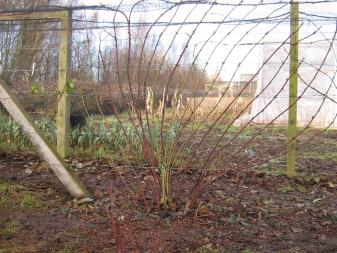

Types of trellises
Supports for shrubs should be made of certain materials and have a height of 1.5-2 meters (average height of a shrub).
There are also some requirements for materials:
- the material should be lightweight and flexible so that it can be easily bandaged;
- the material should not slip: the stems should not move out during strong winds and rub against the wire;
- under the influence of sunlight, chemical sprays or during soil cultivation, the material should not lose its strength;
- when pruning shrubs and harvesting, the material should not damage the plants.

Tapestries are most often made of durable materials: ash, oak, chestnut, acacia. They are also made of plastic: this is a cheaper material, durable, can even withstand a rainstorm, but is harmful to the plant itself, especially when the temperature rises outside.
But there are also metal trellises. They are more durable and resistant to various weather conditions: from autumn showers to winter cold.
When installing trellises, the plant must be braided and cut in a certain way with your own hands. They have several tiers, between which a wire is stretched, ensuring the correct distribution of the branches.

Tapestries differ not only in material, but also in other properties. When choosing, you should pay attention to the following parameters.
- The form. Blackberries can be either creeping or upright, so trellises in the form of an arch, lattice or mesh are suitable. The advantage of the arch is that it can be installed anywhere in the garden (especially if the bush grows in the garden, not on the plantation). The grill is installed only next to a vertical surface (usually a wall or fence), and the mesh is attached to trellises or other support.
- Cell size. The stems of the shrub must pass freely through the apertures of the cells. The size of the cells is determined by how fast the stems grow and how strong and thick they are.
- Height. Different types of blackberries reach approximately the same height, but somewhere centimeters may differ. Therefore, the height of the trellises is provided just above the height of the bush. The main thing is that the stems should not hang down, even the very tip. This can damage the entire branch.
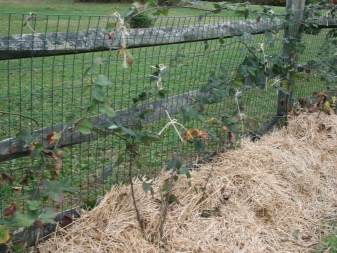
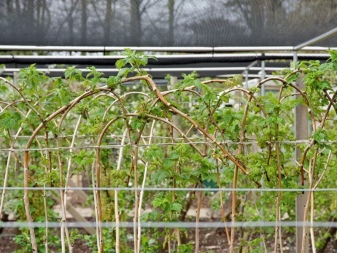
Trellis made of wood and metal must be treated with a special paint for wood surfaces or bitumen mastic. If we talk about the external form, then there are trellises of the following types.
Simple
The arcuate form of the trellis is simple and mobile.
It is enough to deepen two stakes by half a meter at a distance of 1.5-2 m from each other, pull a wire between them or install a grate. Ready!
If the trellises are made of metal, they must be sprinkled on top with sand or gravel so that they do not jump out of the ground.

T-shaped
For greater reliability, the trellises are placed in the form of the letter "T": a stake is driven into the ground and horizontal slats are perpendicularly attached to it at a distance of 30-50 cm from each other (how many slats to fasten depends on the height of the central pillar). On the opposite side, the same structure is placed and a wire is pulled between them, which is attached to each of the rails.
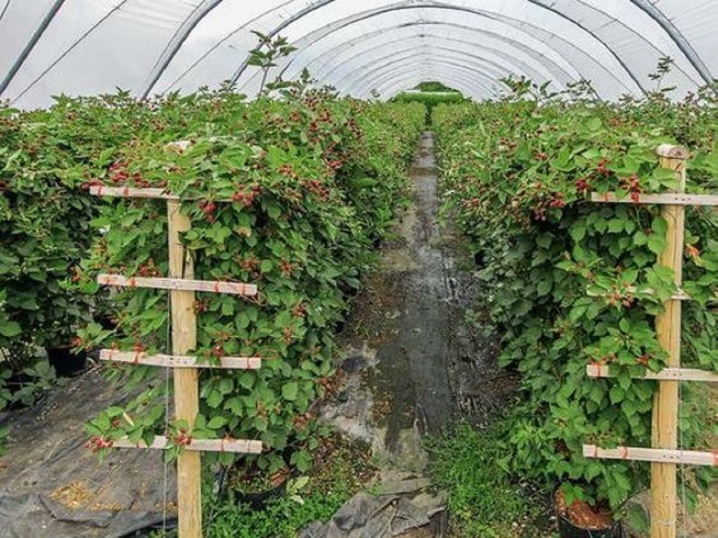
V-shaped
The tapestries are placed at an angle, forming a V-shape. Between them stretch all the same wire and place the stems of the bush.
Modern movable trellises allow you to lay blackberries for the winter without removing them from the wire.

Heat-loving plants can also be grown on the swivel trellis in cold areas. The direction of the tilt is adjustable depending on the weather conditions of the region:
- in the summer, the structure is placed vertically so that the entire crop is warmed up in the sun;
- in winter, the structure is laid on the ground, due to which young shoots are buried under the old ones, which does not allow them to freeze and die;
- in the spring, the support is raised, making room for new shoots and allowing the plant to form buds.

Timing
The blackberry garter is carried out twice a year: in spring and autumn. In the spring, it is carried out as soon as the frosts receded and the young shoots began to gain strength, and in the fall - after the harvest, in order to make the plant more resistant to frost. In the spring, immediately after pruning, the branches of blackberries are raised on trellises, and young shoots are separated from one-year ones.
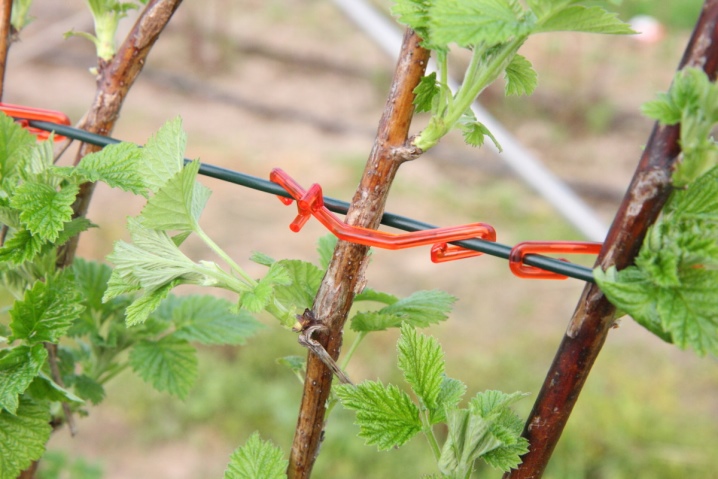
Garter technology
To get a good harvest, blackberries must be tied properly.
If the shrub is grown in the country, then it is better to tie the plant up on trellises (they will keep the branches and fruits intact) or on a lattice placed against the wall or fence.
It looks pretty and the bush stalks will get enough sunlight.

Here's a quick guide on how to tie a blackberry.
- A distance of 30-40 cm should be left between the pieces of wire for tying branches.For plants with weak branches, the distance will be 20-25 cm.
- Each stem should be positioned so that everyone receives the same amount of solar energy.
- As soon as the branch has grown, it is bandaged up one level. The stem should not hang.

Garter methods and technologies are as follows.
- Interlacing. Old shoots are intertwined on the lower tiers, and young ones are straightened for better growth.
- Fan-shaped garter. Old branches are tied to the lower tiers at an angle, the young are pulled up.
- Unilateral tilt. Old branches are tied to a trellis and tilted to the side. When young shoots appear, they are removed in the opposite direction.
Blackberries are a healthy and tasty berry that needs careful care. The garter is a necessary procedure, carried out twice a year, to ensure the correct growth of the garden culture.
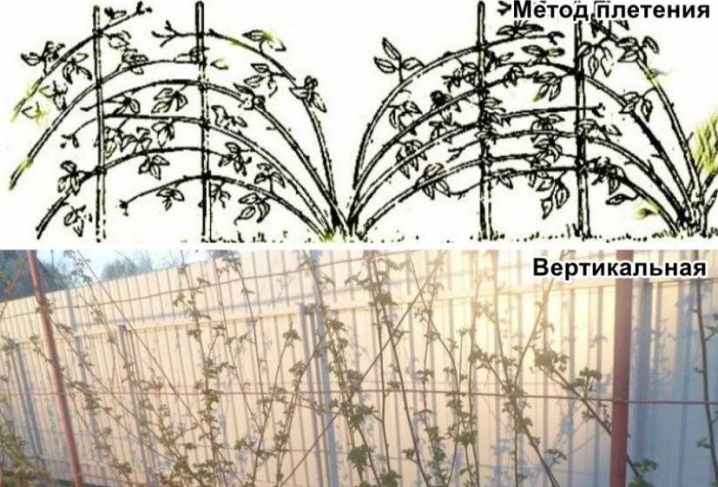













The comment was sent successfully.